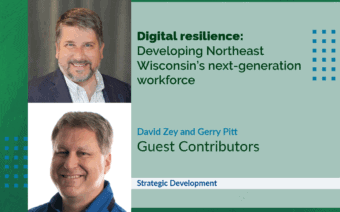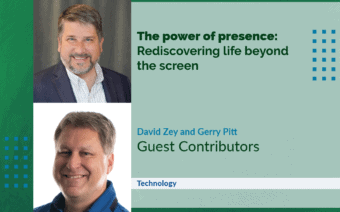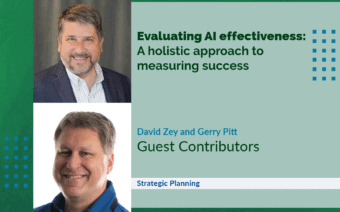
December 2, 2024
It’s no secret that the trucking and logistics industry is facing an uphill battle – a growing driver shortage coupled with a staggering annual turnover rate of 98%.
With more than 3.5 million truck drivers and 1.2 million trucking companies in the U.S. alone, the demand for drivers is immense.
Add seasonal hiring spikes, local labor laws and increased competition, and it’s clear traditional recruitment methods can no longer keep up.
In an industry driven by efficiency, the future could lie in AI-powered solutions, not just for marketing recruitment campaigns but for leveraging advanced AI voice and video sales representatives.
These tools go beyond static job postings or email outreach.
They allow companies to engage candidates in real-time, using conversational AI to personalize communication, screen applicants and even conduct initial interviews via video.
Enhancing applicant engagement is a critical challenge for trucking companies, and AI technology offers a compelling solution.
Josh Hicks from Simba 7 Media demonstrates this with a hybrid approach tailored specifically for the transportation and logistics industry.
By leveraging geofenced campaigns, companies can connect with potential applicants on demand, targeting job seekers based on job type, location and skill set.
Simba 7 Media’s process goes beyond traditional outreach.
Their online algorithm is optimized and monitored over 30-45 days to ensure recruitment efforts align with specific geographical needs.
This approach has successfully filled roles, such as truck drivers, warehouse personnel and diesel mechanics efficiently.
What’s more, the strategy doubles as a sales tool, enabling logistics companies to conduct targeted outreach to customers for available capacity in open lanes or warehouse space.
These needs are often met within just two to four weeks, showcasing the speed and precision of AI-driven campaigns.
The impact is transformative.
Traditional recruitment methods require hours of manual effort – sifting through resumes, contacting candidates and scheduling interviews.
By automating these tasks, AI-powered tools make the process faster, smarter and more efficient.
Voice and video AI sales assistants also free recruiters to focus on high-value tasks, while maintaining an engaging presence in the hiring pipeline.
Recruitment has always been a labor-intensive process involving screening resumes, contacting potential hires and navigating various stages of evaluation.
Traditional methods are no longer sufficient to meet hiring demands in industries like trucking and logistics, where turnover rates hover at a staggering 98% and driver shortages continue to grow.
AI offers a transformative solution, but its implementation comes with both opportunities and limitations.
The pros of AI in recruitment
Efficiency
One of AI’s most significant contributions to recruitment is the ability to automate time-consuming tasks:
- Resume screening: AI-powered tools can sift through thousands of applications in minutes, identifying top candidates based on predefined criteria like skills, experience and certifications.
- Initial engagement: Conversational AI, such as chatbots, can handle candidate inquiries, provide job details and even schedule interviews, saving recruiters hours of manual effort.
Enhanced candidate matching
AI algorithms can analyze candidate data against job requirements with unmatched precision.
This improves the quality of hires by identifying candidates who not only meet the technical qualifications but are also a good fit for the organization’s culture.
Cost savings
AI significantly lowers the cost-per-hire by automating repetitive tasks with internal recruiters or staff and reducing the need to hire external recruiting agencies.
Companies using AI in recruitment report savings of 30-plus% in recruitment budgets.
We see this number climb daily as we implement more AI tools.
Scalability
AI systems can handle high volumes of applications, making them ideal for industries like trucking that experience seasonal hiring spikes or need to fill multiple roles simultaneously.
The cons of AI in recruitment
Lack of human judgment
Though AI excels at analyzing data, it cannot replace human intuition and judgment.
For example:
- It may overlook candidates with non-traditional career paths who possess valuable skills.
- It cannot always assess interpersonal qualities or cultural fit, which are critical for long-term success in many roles.
Potential for bias
AI tools are only as unbiased as the data on which they are trained.
If historical hiring data contains biases, such as favoring specific demographics, AI may perpetuate those biases.
Over-reliance on technology
AI-driven systems can sometimes filter out candidates too aggressively, leading to the rejection of potentially strong applicants.
Over-reliance on AI without human oversight risks creating a “black box” hiring process where decisions lack transparency and flexibility.
Initial implementation challenges
Adopting AI tools requires upfront investment, both in terms of cost and training.
Companies must also ensure their systems integrate seamlessly with existing workflows and platforms.
Though upfront investments in cost and training are needed, many companies see returns within months through faster hiring cycles and reduced costs.
Screening job candidates with AI: A balanced approach
How AI-assisted screening works
- Data analysis: AI tools analyze resumes to identify keywords, qualifications and other suitability indicators.
- Behavioral insights: Advanced tools evaluate patterns in candidate responses during online assessments or interactions with chatbots.
- Prioritization: AI ranks candidates based on their match with job requirements, enabling recruiters to focus on the most promising profiles.
The hybrid model for AI
To address the limitations of AI, many companies are adopting a hybrid approach:
- AI for initial screening: Automate the first or second layer of candidate filtering to reduce workload.
- Human expertise for final evaluation: Recruiters handle second- or third-round interviews and cultural assessments, ensuring that hiring decisions align with organizational goals.
This model ensures that businesses benefit from AI’s efficiency while maintaining a personal touch essential for effective recruitment.
Real-world applications in recruitment
Geographic targeting
AI tools analyze regional labor market data to identify areas with a high density of qualified candidates.
This is particularly effective in trucking, where location plays a significant role in hiring.
Conversational AI
Chatbots and sales AI representatives engage candidates in real-time, answering questions about job responsibilities, salary and benefits, while pre-screening the candidate.
This keeps candidates engaged while reducing the workload for human recruiters.
Results
Companies that use AI-assisted recruitment in the trucking industry report:
- 30–50% faster hiring cycles
- 25–40% reduction in recruitment costs
- Higher-quality hires due to more precise candidate matching
Getting started with AI in recruitment
Is AI right for your business?
AI is most effective for businesses facing challenges such as:
- High-volume recruitment needs
- Long hiring cycles due to manual processes
- Inefficiencies in candidate screening
Common pitfalls to avoid
- Ignoring human oversight: Ensure that recruiters are involved in decision-making, especially in the final stages of the hiring process.
- Failure to monitor bias: Regularly audit AI systems to ensure that they are not perpetuating discriminatory practices.
Implementation tips
- Start small by integrating AI into specific stages of recruitment, such as resume screening or candidate engagement.
- Choose tools that align with your business’s specific needs and goals.
- Provide training for recruiters to effectively use and monitor AI systems.
AI is no longer a luxury but a necessity in the competitive world of recruitment and marketing.
Its ability to automate repetitive tasks, analyze data with precision and streamline workflows has transformed how businesses operate, particularly in industries like transportation, where time-to-hire and cost efficiency are critical.
However, the true power of AI is unlocked when paired with human expertise.
Recruiting solutions are not just about AI
Recruitment innovation isn’t confined to AI.
Many proven solutions, particularly in geographic recruitment, rely on traditional yet highly effective marketing strategies.
For example, campaigns that target specific geographic areas and allow for precise adjustments in volume can dramatically enhance recruitment pipelines.
These strategies don’t require AI but do depend on a blend of marketing expertise and business-specific recruitment knowledge.
This highlights an important truth: improving recruitment isn’t about the latest technology – it’s about achieving results through a combination of knowhow, experience, specialized craft and technology.
The key is “and,” not “or.”
When combined with AI tools, these proven strategies can create a seamless recruitment pipeline that maximizes both precision and personalization.
A hybrid model for recruitment
Given this perspective, a hybrid approach – like the one Simba 7 Media has pioneered – ensures the strengths of AI are fully leveraged while preserving the creativity, empathy and strategic thinking only humans can provide to specific business use cases.
By combining cutting-edge AI tools with proven recruitment and marketing strategies, Simba 7 Media continues to lead in delivering results that drive businesses forward.
Whether optimizing geographic targeting, enhancing candidate engagement or refining campaign strategies, a hybrid model bridges the gap between automation and personalization.
Companies that embrace this approach not only stay competitive but also position themselves as leaders in their industries.
The question isn’t whether to adopt AI but how to do so effectively.
With the right tools and a balanced strategy, the future of recruitment and marketing is one of unparalleled potential.
 Summery scents, sights at Suring’s Lavender Homestead
Summery scents, sights at Suring’s Lavender Homestead ‘I don’t believe in trying, I believe in doing’
‘I don’t believe in trying, I believe in doing’







